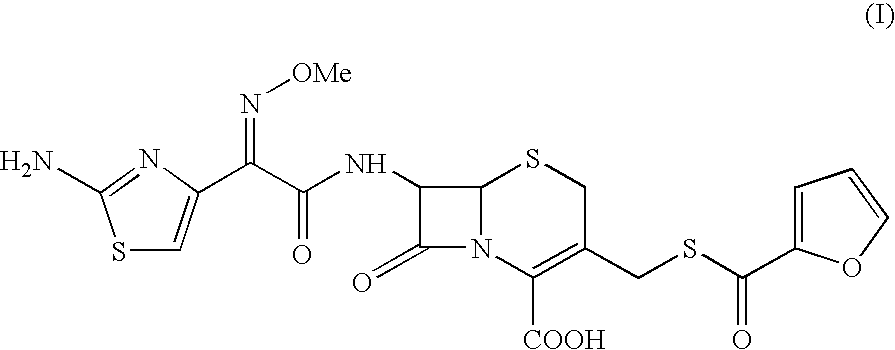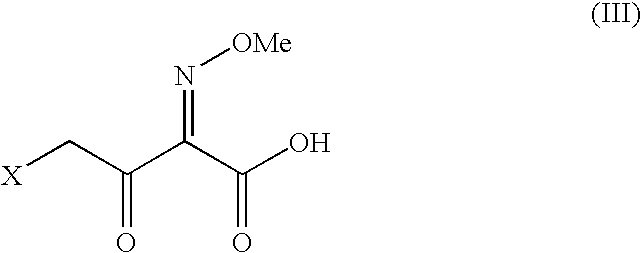Method for the preparation of ceftiofur sodium and its intermediates
a technology of ceftiofur and ceftiofur sodium, which is applied in the field of new ceftiofur sodium and its intermediates, and the method of ceftiofur acid, can solve the problems of difficult purification of difficult to purify the derivative of ceftiofur, and the preparation of ceftiofur sodium has posed challenges to organic chemists in purity, stability and crystallinity, and achiev
- Summary
- Abstract
- Description
- Claims
- Application Information
AI Technical Summary
Benefits of technology
Problems solved by technology
Method used
Image
Examples
example-2
Preparation of 7-amino-3-[(fur-2-ylcarbonyl)thiomethyl]-3-cephem-4-carboxylic Acid p-methoxy benzyl ester
Flask-A
Dichloromethane (60 ml) was charged and cooled to -20.degree. C. Phosphorous penta chloride (7.2 g) was added followed by POCl.sub.3 (1.3 g) and the suspension was stirred for 15 minutes. Pyridine (7.0 g) was charged slowly at -30 to 40.degree. C. The solution of 7-phenylacetamido-3-[(fur-2-ylcarbonyl)thiomethyl]-3-cephem-4-carboxylic acid p-methoxy benzyl ester (10.0 g) in 40 ml of dichloromethane was slowly added to this mixture. The reaction mixture was stirred for 1.0 hour at -30.degree. C.
Flask-B
In an another flask, methanol (200 ml) was taken and cooled to -40.degree. C. and to this cooled methanol, solution from flask A was added in 1.0 hour by maintaining temperature at -10 to -15.degree. C. Solution becomes dark brown in color. Temperature was brought up to 0-10.degree. C. The reaction was monitored by HPLC for complete disappearance of starting material. After co...
example-3
Preparation of 7-[(2-(syn)methoxyimino-3-oxo-4-chlorobutyrylamino]-3-[(fur-2-ylcarbonyl)thiomethyl]-3-cephem-4-carboxylic acid p-methoxy benzyl ester
Flask-A
Dichloromethane (75 ml) was charged at room temperature, followed by 7-amino-3-[(fur-2-ylcarbonyl)thiomethyl]-3-cephem-4-carboxylic acid p-methoxy benzyl ester (15.0 g) and N,O-bis-(trimethylsilyl)acetamide (BSA) (100 g) drop wise at room temperature. The mixture was stirred at room temperature for 1 hour to get clear solution.
Flask-B
4-Chloro-3-oxo-methoxyimino-butyric acid (6.4 g) was dissolved in dichloromethane (75 ml) at room temperature. The solution was cooled to -30.degree. C., PCl.sub.5 (7.4 g) was added portion wise at -30.degree. C. and stirred at -30.degree. C. for 30 minutes. The reaction mass in flask B at -30.degree. C. was transferred into pre cooled silylated mixture in flask A. Mixture was stirred at -30.degree. C. for 15-20 minutes and progress of the reaction was monitored by HPLC. After completion of reaction,...
example-4
Preparation of 7-[(2-(syn)methoxyimino-3-oxo-4-bromobutyrylamino]-3-[(fur-2-ylcarbonyl)thiomethyl]-3-cephem-4-carboxylic Acid p-methoxybenzylester
Flask-A
Dichloromethane (75 ml) was charged at room temperature, followed by the addition of 7-amino-3-[(fur-2-ylcarbonyl)thiomethyl]-3-cephem-4-carboxylic acid p-methoxy benzyl ester (15.0 g) and N,O-bis-(trimethylsilyl)acetamide (BSA) (100 g) drop wise at room temperature. The mixture was stirred at room temperature for 1 hour to get clear solution.
Flask-B
4-Bromo-3-oxo-methoxyimino-butyric acid (9.3 g) was dissolved in dichloromethane (75 ml) at room temperature. The solution was cooled to -30.degree. C. and PCl.sub.5 (7.4 g) was added portion wise at -30.degree. C. The mixture was stirred at -30.degree. C. for 30 minutes. The reaction mass in flask B at -30.degree. C. was transferred into pre cooled silylated mixture in flask A. The reaction mixture was stirred at -30.degree. C. for 15-20 minutes and progress of the reaction was monitore...
PUM
| Property | Measurement | Unit |
|---|---|---|
| temperature | aaaaa | aaaaa |
| temperature | aaaaa | aaaaa |
| temperature | aaaaa | aaaaa |
Abstract
Description
Claims
Application Information
 Login to View More
Login to View More - R&D
- Intellectual Property
- Life Sciences
- Materials
- Tech Scout
- Unparalleled Data Quality
- Higher Quality Content
- 60% Fewer Hallucinations
Browse by: Latest US Patents, China's latest patents, Technical Efficacy Thesaurus, Application Domain, Technology Topic, Popular Technical Reports.
© 2025 PatSnap. All rights reserved.Legal|Privacy policy|Modern Slavery Act Transparency Statement|Sitemap|About US| Contact US: help@patsnap.com



